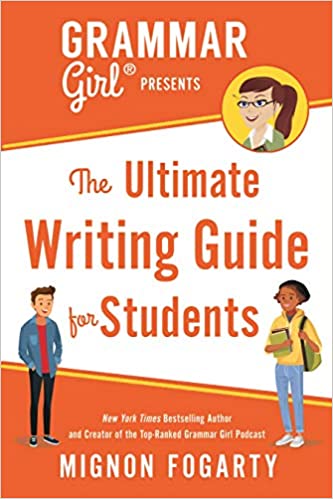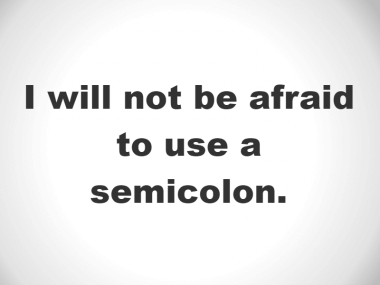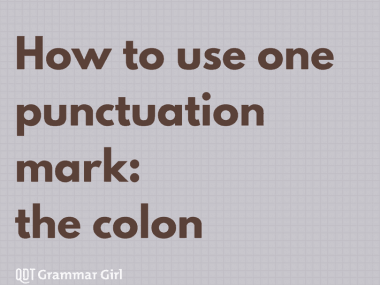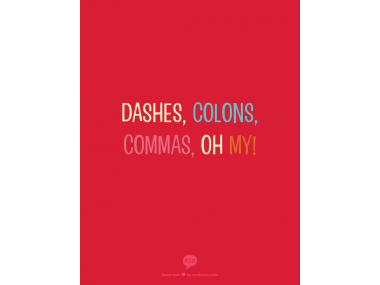Semicolons
Think of semicolons as sentence splicers.
I get questions about semicolons a lot, so it’s time to clear up some confusion.
Use semicolons to separate things and add variety
Semicolons separate things. Most commonly, they separate two main clauses that are closely related to each other but that could stand on their own as sentences if you wanted them to.
Here’s an example: “Squiggly loves chocolate; he even put it on his tacos once.” The two parts of that long sentence that are separated by a semicolon could be sentences on their own if you put a period between them: Squiggly loves chocolate. He even put it on his tacos once.
One reason you might choose to use a semicolon instead of a period is if you want to add variety to your sentence structure, for example, if you thought you had too many short, choppy sentences in a row. But when you use a semicolon, the main clauses should be closely related to each other. You wouldn’t write, “It was below zero outside; Squiggly loves chocolate,” because those two main clauses have nothing to do with each other. In fact, the other reason to use a semicolon instead of a period is if you want to draw attention to the relationship between the two clauses.
Now let’s talk about the two forms of punctuation that are most commonly misused in place of semicolons:
- Semicolons versus colons
- Semicolons versus commas
Semicolons versus colons
People often ask me what the difference is between a semicolon and a colon, and there are a couple of differences.
First, the purpose of a colon is to introduce or define something. For example, you could write, “Squiggly checked the temperature: it was -20 degrees outside.” I’ll admit that these differences can be subtle, but I would use a colon in that sentence instead of a semicolon because the second clause (the temperature) strongly relates back to the first clause (Squiggly checking the temperature).
Semicolons separate things. Most commonly, they separate two main clauses that are closely related to each other but could stand on their own as sentences.
The second difference between a colon and a semicolon is that when you are joining things, you use a semicolon to join things of equal weight, whereas you can use a colon to join things of equal or unequal weight. For example, you can use either a semicolon or a colon to join two main clauses, but you can only use a colon to join a main clause with a noun. Here’s an example: “Squiggly has a favorite flavor: chocolate.” You couldn’t use a semicolon in that sentence because the two parts are unequal.
Buy Now

One way I remember this is to think of the different elements as railroad cars. (In my imagination it’s the train in the “Schoolhouse Rock” cartoon “Conjunction Junction.”) I use a semicolon only if I’m joining two equal “boxcars.” If I’m joining two unequal elements, like a boxcar and a caboose—a clause and a noun— then I know that I can’t use a semicolon, and I consider whether a colon makes sense. So equal sentence boxcars get a semicolon, and unequal sentence boxcars and cabooses often get a colon (or a dash).I have a full episode about how to use colons, so you can refer to that if you need more information.
Semicolons versus commas
Also, one important thing to remember is that you almost never use semicolons with coordinating conjunctions such as “and,” “or,” and “but” when you’re joining two main clauses. Instead, if you’re joining two main clauses with a coordinating conjunction, you use a comma. For example, “Squiggly loves chocolate, and he even put it on his tacos once.”
I don’t want to confuse you, but there is one situation where you use semicolons with coordinating conjunctions, and that’s when you are writing a list of items, and commas just don’t do the job of separating them all. Here’s an example: “This week’s winners are Dorothy from Seattle, Washington; Matt from Phoenix, Arizona; and Brian from Miami, Florida.” Because each item in the list requires a comma to separate the city from the state, you have to use a semicolon to separate the items themselves. “Dorothy from Seattle, Washington; Matt from Phoenix, Arizona; [and so on].”
Semicolons with conjunctive adverbs
Finally, you use a semicolon when you use a conjunctive adverb to join two main clauses. Conjunctive adverbs are words such as “however,” “therefore,” and “indeed,” and they “usually show cause and effect, sequence, contrast, comparison, or other relationships.” (1) For example, “Aardvark is on vacation; therefore, Squiggly has to carry the weight in this episode.”
People sometimes seem frustrated because they have to remember to use commas with coordinating conjunctions and semicolons with conjunctive adverbs, but if you can’t keep the difference straight in your head, it can help to remember that commas are smaller than semicolons and go with coordinating conjunctions, which are almost always short two- or three-letter words—small punctuation mark, small words. Semicolons are bigger, and they go with conjunctive adverbs, which are almost always longer than three letters—bigger punctuation, bigger words. I’ll put a list of the two kinds of connectors at the bottom of this transcript.
| Country | |
|---|---|
| Common Coordinating Conjunctions | Common Conjunctive Adverbs |
| Use these with commas to join main clauses | Use these with semicolons to join main clauses |
| and | accordingly |
| but | again |
| nor | also |
| or | besides |
| so | consequently |
| yet | finally |
| for* | furthermore |
| hence | |
| however | |
| incidentally | |
| indeed | |
| likewise | |
| moreover | |
| namely | |
| nevertheless | |
| nonetheless | |
| otherwise | |
| similarly | |
| still | |
| that is | |
| then | |
| therefore | |
| thus |
Semicolon photo, ilovememphis at Flickr. CC BY-ND 2.0






